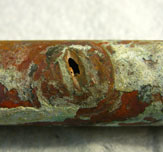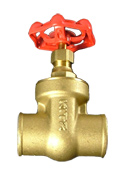How to check for hidden leaks
 Leaks waste water and cause serious damage, especially where you can't see them. Many leaks can also be of a small enough quantity that you would never notice them on your water bill. Small leaks can become big ones (big expensive ones!). In the photo to the right, the copper pipe failed from the inside, corroded completely through, and formed a leak, the water eroding the copper to form an even larger hole.
Leaks waste water and cause serious damage, especially where you can't see them. Many leaks can also be of a small enough quantity that you would never notice them on your water bill. Small leaks can become big ones (big expensive ones!). In the photo to the right, the copper pipe failed from the inside, corroded completely through, and formed a leak, the water eroding the copper to form an even larger hole.
Greg demonstrates a very easy way to check for leaks by using an inexpensive pressure gauge (less than $10 at the home center). In the video you'll see what it looks like when there is a leak and also when there is not one.
To do this, a gauge is attached to a hose bibb on the building side of the shut-off valve. Then, the valve is closed to trap pressure in the system. If there are no leaks the system will hold the pressure over night. In this video, we demonstrate the leak rate with a slowly dripping faucet (though the leak could easily be a hidden one).
 An important aspect for this type of test to work is that the shut-off valve makes a good solid seal. If you have a ball valve like this one, it's sure to meet that requirement. These valves turn 90° to shut off and often have a lever handle as shown.
An important aspect for this type of test to work is that the shut-off valve makes a good solid seal. If you have a ball valve like this one, it's sure to meet that requirement. These valves turn 90° to shut off and often have a lever handle as shown.
 However, if your water shut off is a gate valve (as shown to the left), then a tight seal is not guaranteed. Test results that appear to show "no leaks" may actually not be the case. If the valve leaks close to the amount that the inside pipes are leaking then you will not be able to detect a leak in this case.
However, if your water shut off is a gate valve (as shown to the left), then a tight seal is not guaranteed. Test results that appear to show "no leaks" may actually not be the case. If the valve leaks close to the amount that the inside pipes are leaking then you will not be able to detect a leak in this case.
| Time to complete | up to 30 min, but you may want the test to run overnight. |
| Materials | water pressure gauge, channel locks or other pliers |
| Costs | about $10 (for the pressure gauge.) |
| Skill level | easy |